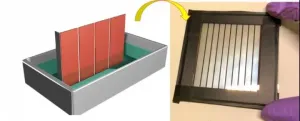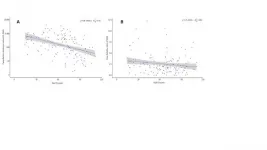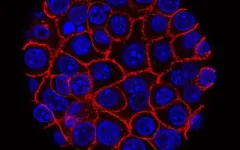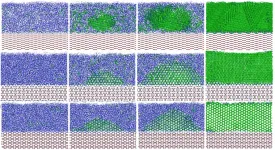Could leak in blood-brain barrier be cause of poor memory?
Researchers review 150 articles to determine what happens when the blood-brain barrier ages
2021-03-18
(Press-News.org) Have you forgotten where you laid your keys? Ever wondered where you had parked your car? Or having trouble remembering the name of the new neighbor? Unfortunately, these things seem to get worse as one gets older. A big question for researchers is where does benign forgetfulness end and true disease begin?
One of the keys to having a healthy brain at any age is having a healthy blood-brain barrier, a complex interface of blood vessels that run through the brain. Researchers reviewed more than 150 articles to look at what happens to the blood-brain barrier as we age. Their findings were published March 15 in Nature Aging.
Whether the changes to the blood-brain barrier alters brain function, however, is still up for debate.
"It turns out very little is known how the blood-brain barrier ages," said lead author William Banks, a gerontology researcher at the University of Washington School of Medicine, and a researcher with the Geriatrics Research Education and Clinical Center at the Veterans Affairs Puget Sound Health Care System. "It's often hard to tell normal aging from early disease."
The blood-brain barrier, discovered in the late 1800s, prevents the unregulated leakage of substances from blood into the brain. The brain is an especially sensitive organ and cannot tolerate direct exposure to many of the substances in the blood. Increasingly, scientists have realized that the blood-brain barrier also allows many substances into the brain in a regulated way to serve the nutritional needs of the brain. It also transports informational molecules from the blood to the brain and pumps toxins out of the brain. A malfunctioning blood-brain barrier can contribute to diseases such as multiple sclerosis, diabetes, and even Alzheimer's disease.
Before scientists can understand how such malfunctioning can contribute to the diseases of aging, they need to understand how a healthy blood-brain barrier normally ages.
Research shows that healthy aging individuals have a very small leak in their blood-brain barrier. This leakage is associated with some measures of the benign forgetfulness of aging, considered by most scientists to be normal. But could this leak and the difficulties in recall be the early stages of Alzheimer's disease?
When a person carries the ApoE4 allele, the strongest genetic risk of Alzheimer's risk, researchers said there is an acceleration of most of the blood-brain barrier age-related changes.
People with ApoE4 have a hard time getting rid of amyloid beta peptide in their brains, which causes an accumulation of plaque. With healthy aging, the pumps in the blood-brain barrier work less efficiently in getting rid of the amyloid beta peptide. The pumps work even less well in people with Alzheimer's disease.
Another key finding in the review is that as we age, two cells begin to change in the blood-brain barrier: pericytes and astrocytes.
Recent work suggests that the leak in the blood-brain barrier that occurs with Alzheimer's may be due to an age-related loss of pericytes. Astrocytes, by contrast, seem to be overactive. Recent work suggests that preserving pericyte function by giving the factors that they secrete or even transplanting them could lead to a healthier blood-brain barrier.
Some research suggests that pericyte health can be preserved by some of the same interventions that extend lifespan, such as regular exercise, caloric restriction, and rapamycin.
Other findings raise the question of whether the brain's source of nutrition and its grip on control of the immune and endocrine systems could deteriorate with aging. Another finding raises the possibility that the rate at which many drugs are taken up by the brain may explain why older folks sometimes have different sensitivities to drugs than their children or grandchildren.
INFORMATION:
ELSE PRESS RELEASES FROM THIS DATE:
2021-03-18
LOS ALAMOS, N.M., March 18, 2021--A new, simpler solution process for fabricating stable perovskite solar cells overcomes the key bottleneck to large-scale production and commercialization of this promising renewable-energy technology, which has remained tantalizingly out of reach for more than a decade.
"Our work paves the way for low-cost, high-throughput commercial-scale production of large-scale solar modules in the near future," said Wanyi Nie, a research scientist fellow in the Center of Integrated Nanotechnologies at Los Alamos National Laboratory and corresponding ...
2021-03-18
During a pandemic like COVID-19, vulnerable countries are traditionally the focus of global attention and concern. However, new research suggests that we need to rebuild our understanding. A study published in KeAi's Global Health Journal, examined the relationship between state vulnerabilities (measured using the Fragile States Index (FSI) from Fund for Peace) and COVID-19 incidence and death rates in 146 countries. The FSI consists of 12 specific indicators covering cohesion, economy, politics and society. "When using the total FSI score for statistical analysis, we were surprised to find that, overall, the more fragile countries had lower cumulative incidence and fatality rates for COVID-19," explains one of the study's authors, Yangmu ...
2021-03-18
In new findings published online March 18, 2021 in the journal Cancer Cell, an international team of researchers, led by scientists at University of California San Diego School of Medicine and Moores Cancer Center, describe how pancreatic cancer cells use an alternative method to find necessary nutrients, defying current therapies, to help them grow and spread.
Pancreatic cancer accounts for roughly 3 percent of all cancers in the United States, but it is among the most aggressive and deadly, resulting in 7 percent of all cancer deaths annually. Pancreatic cancer is especially deadly once it metastasizes, with the number of people who are alive five years later declining from 37 percent to just 3 percent.
All cancer cells require a constant supply of nutrients. Some types ...
2021-03-18
Smart glass can change its color quickly through electricity. A new material developed by chemists of Ludwig-Maximilians-Universität (LMU) in Munich has now set a speed record for such a change.
On the highway at night. It rains, the bright headlights of the car behind you are blinding. How convenient to have an automatically dimming rearview mirror in such a case. Technically, this helpful extra is based on electrochromic materials. When a voltage is applied, their light absorption and color change. Controlled by a light sensor, the rearview mirror can thus filter out strongly dazzling light.
Recently, experts discovered that, in addition to established inorganic electrochromic materials, a new generation of highly ordered lattice structures can also be equipped ...
2021-03-18
KINSHASA, DEMOCRATIC REPUBLIC OF CONGO (March 18, 2021) - A new study in the journal Conservation Science and Practice finds that restaurants in urban areas in Central Africa play a key role in whether protected wildlife winds up on the menu.
The study, by a team of scientists from Michigan State University, Wildlife Conservation Society (WCS), and University of Maryland, used a crime science "hot product" approach, which looks at frequently stolen items coveted by thieves. The approach offered new insights into wildlife targeted by the urban wild meat trade and can inform urban wildlife policies.
The study engaged lower, middle, and upper-level tiered restaurants to understand which species were traded. ...
2021-03-18
Detailed, new analysis published this week in the British Medical Journal (BMJ) Open highlights significant concerns about a growing issue of sex selective abortion of girls in Nepal.
Drawing on census data from 2011 and follow-on survey data from 2016, the social scientists estimate that roughly one in 50 girl births were 'missing' from records (i.e. had been aborted) between 2006-11 (22,540 girl births in total). In the year before the census (June 2010 - June 2011) this had risen to one in 38.
For certain areas of the country, the practice was more widespread. In Arghakhanchi, the most affected district, one in every six girl births were 'missing' in census data. In the Kathmandu Valley, Nepal's main urban centre, around 115 boys are born for ...
2021-03-18
Anyone who has watched an infant's eyes follow a dangling trinket dancing in front of them knows that babies are capable of paying attention with laser focus.
But with large areas of their young brains still underdeveloped, how do they manage to do so?
Using an approach pioneered at Yale that uses fMRI (or functional magnetic resonance imaging) to scan the brains of awake babies, a team of university psychologists show that when focusing their attention infants under a year of age recruit areas of their frontal cortex, a section of the brain involved in more advanced functions that was previously thought to be immature in babies. The findings were ...
2021-03-18
At the heart of clouds are ice crystals. And at the heart of ice crystals, often, are aerosol particles - dust in the atmosphere onto which ice can form more easily than in the open air.
It's a bit mysterious how this happens, though, because ice crystals are orderly structures of molecules, while aerosols are often disorganized chunks. New research by Valeria Molinero, distinguished professor of chemistry, and Atanu K. Metya, now at the Indian Institute of Technology Patna, shows how crystals of organic molecules, a common component of aerosols, can get the ...
2021-03-18
Observations of groups of wild bonobos, reported in Scientific Reports, suggest that two infants may have been adopted by adult females belonging to different social groups. The findings may represent the first report of cross-group adoption in wild bonobos, and potentially also the first cases of cross-group adoption in wild apes.
Bonobos form social groups of multiple males and females that sometimes temporarily associate with one another. Nahoko Tokuyama and colleagues observed four groups of wild bonobos between April 2019 and March 2020 in the Luo Scientific Reserve in Wamba, Democratic Republic of the Congo. The authors identified two infants whom ...
2021-03-18
Newly excavated skeletal remains of an ankylosaurid -- a large armoured herbivore that lived during the Cretaceous Period -- may indicate that members of this family of dinosaurs were able to dig, according to a study published in Scientific Reports. The specimen, known as MPC-D 100/1359, may further our understanding of ankylosaurid behaviour during the Late Cretaceous (84-72 million years ago).
Yuong-Nam Lee and colleagues excavated the skeletal elements of MPC-D 100/1359 from a deposit of the Baruungoyot Formation in the southern Gobi Desert, Mongolia, ...
LAST 30 PRESS RELEASES:
[Press-News.org] Could leak in blood-brain barrier be cause of poor memory?
Researchers review 150 articles to determine what happens when the blood-brain barrier ages





